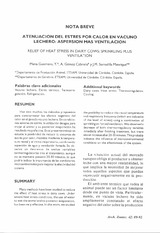Atenuación del estrés por calor en vacuno lechero: aspersión más ventilación
Relief of heat stress in dairy cows: sprinkling plus ventilation
Autor
Gómez Cabrera, Augusto
Mena Guerrero, Y.
Serradilla Manrique, J.M.
Editor
Universidad de Córdoba, Servicio de PublicacionesFecha
1993Materia
RefrigeraciónEstrés térmico
Termorregulación
Vacuno de leche
METS:
Mostrar el registro METSPREMIS:
Mostrar el registro PREMISMetadatos
Mostrar el registro completo del ítemResumen
Many methods have been studied to reduce the effect of heat stress in dairy cows. Under severe heat stress conditions, the use of water to wet the animal and its posterior evaporation, has been very effective. In this work, we studied the posibility to reduce the rectal temperature and respiratory frecuency (which are indicative of the level of stress) using a combination of sprinkling an forced ventilation. We observed a decrease of both thermorregulatory variables inmediatly after finishing treatment, but there was an increase after 20-30 minutes.This probably indicates the influence of microenvironmental conditions on the effectiviness of the system. Han sido muchos los métodos propuestos para contrarrestar los efectos negativos del calor en el ganado vacuno lechero. En condiciones severas de estrés, la utilización de agua para mojar al animal y su posterior evaporación ha resultado muy efectiva. En el presente trabajo se estudia la posibilidad de reducir lo síntomas de estrés por calor, medidos mediante la temperatura rectal y el ritmo respiratorio, combinando aspersión de agua y ventilación forzada. Se observa un descenso de ambas variables termo rregu lato rías tras el tratamiento, aunque no se mantiene pasados 20-30" minutos, lo que podría indicar la importancia de las condiciones microambientales para mejorar la efectividad del sistema.

